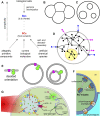The Rise of the Nested Multicompartment Model in Synthetic Cell Research
- PMID: 34540903
- PMCID: PMC8446550
- DOI: 10.3389/fmolb.2021.750576
The Rise of the Nested Multicompartment Model in Synthetic Cell Research
Keywords: artificial cells; membrane proteins; multicompartment; multivesicular vesicles; nested design; synthetic cells; vectorial chemistry; vesosomes.
Conflict of interest statement
The authors declare that the research was conducted in the absence of any commercial or financial relationships that could be construed as a potential conflict of interest.
Figures

Similar articles
-
Microfluidic Assembly of Monodisperse Vesosomes as Artificial Cell Models.J Am Chem Soc. 2017 Jan 18;139(2):587-590. doi: 10.1021/jacs.6b10977. Epub 2016 Dec 20. J Am Chem Soc. 2017. PMID: 27978623
-
Molecular recognition and organizational and polyvalent effects in vesicles induce the formation of artificial multicompartment cells as model systems of eukaryotes.Acc Chem Res. 2014 May 20;47(5):1475-82. doi: 10.1021/ar4002679. Epub 2014 Apr 15. Acc Chem Res. 2014. PMID: 24735049 Review.
-
Multicompartment Polymeric Nanocarriers for Biomedical Applications.Macromol Rapid Commun. 2020 Sep;41(18):e2000298. doi: 10.1002/marc.202000298. Epub 2020 Jul 19. Macromol Rapid Commun. 2020. PMID: 32686228 Review.
-
Formation of artificial multicompartment vesosome and dendrosome as prospected drug and gene delivery carriers.J Control Release. 2013 Aug 28;170(1):141-52. doi: 10.1016/j.jconrel.2013.05.011. Epub 2013 May 23. J Control Release. 2013. PMID: 23707326 Review.
-
Building a synthetic mechanosensitive signaling pathway in compartmentalized artificial cells.Proc Natl Acad Sci U S A. 2019 Aug 20;116(34):16711-16716. doi: 10.1073/pnas.1903500116. Epub 2019 Aug 1. Proc Natl Acad Sci U S A. 2019. PMID: 31371493 Free PMC article.
Cited by
-
Lipid vesicle-based molecular robots.Lab Chip. 2024 Feb 27;24(5):996-1029. doi: 10.1039/d3lc00860f. Lab Chip. 2024. PMID: 38239102 Free PMC article. Review.
-
Monitoring the advancements in the technology of artificial cells by determining their complexity degree: Hints from complex systems descriptors.Front Bioeng Biotechnol. 2023 Feb 1;11:1132546. doi: 10.3389/fbioe.2023.1132546. eCollection 2023. Front Bioeng Biotechnol. 2023. PMID: 36815888 Free PMC article. No abstract available.
-
Light energy transduction in liposome-based artificial cells.Front Bioeng Biotechnol. 2023 Mar 29;11:1161730. doi: 10.3389/fbioe.2023.1161730. eCollection 2023. Front Bioeng Biotechnol. 2023. PMID: 37064236 Free PMC article. Review.
-
pH-Triggered Assembly of Endomembrane Multicompartments in Synthetic Cells.ACS Synth Biol. 2022 Jan 21;11(1):366-382. doi: 10.1021/acssynbio.1c00472. Epub 2021 Dec 10. ACS Synth Biol. 2022. PMID: 34889607 Free PMC article.
-
A four-track perspective for bottom-up synthetic cells.Front Bioeng Biotechnol. 2022 Sep 30;10:1029446. doi: 10.3389/fbioe.2022.1029446. eCollection 2022. Front Bioeng Biotechnol. 2022. PMID: 36246382 Free PMC article. No abstract available.
References
-
- Angelova A., Angelov B., Garamus V. M., Drechsler M. (2019). A Vesicle-To-Sponge Transition via the Proliferation of Membrane-Linking Pores in ω-3 Polyunsaturated Fatty Acid-Containing Lipid Assemblies. J. Mol. Liquids 279, 518–523. 10.1016/j.molliq.2019.01.124 - DOI
-
- Belluati A., Thamboo S., Najer A., Maffeis V., Planta C., Craciun I. (2020). Multicompartment Polymer Vesicles with Artificial Organelles for Signal-Triggered Cascade Reactions Including Cytoskeleton Formation. Adv. Funct. Mater. 30, 2002949. 10.1002/adfm.202002949 - DOI
LinkOut - more resources
Full Text Sources

